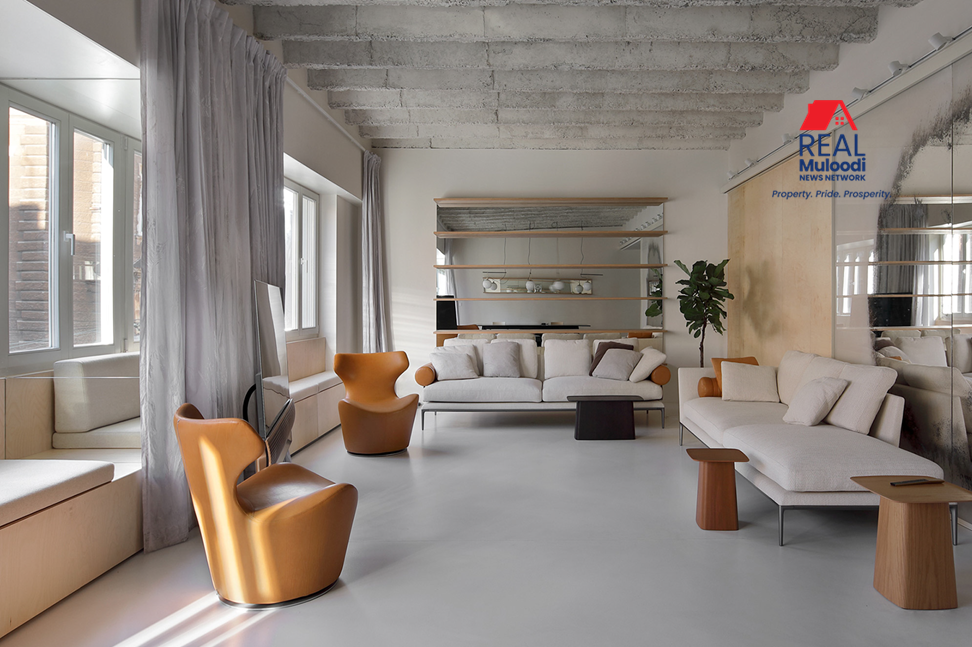UGANDA, Kampala | Real Muloodi News | In the world of construction and design, a transformative player has emerged, quietly revolutionising the way we envision floors and walls. Micro-topping, also referred to as micro cement, is a versatile and decorative material that is taking the design industry by storm.
It offers an innovative alternative to traditional finishes like tiles and terrazzo. This remarkable cement-based product, composed of fine aggregates, liquid polymers, and additives, is a game-changer in the realms of aesthetics, durability, and functionality.
The Rise of Micro-Topping: A Paradigm Shift
Micro-topping’s growing popularity has begun to reshape the construction and design landscape. With its demand predominantly coming from the hotel industry, this innovative material is now finding its way into residential properties.
At just 3mm in thickness, it is applied seamlessly to a variety of surfaces, including concrete floors, walls, ceilings, and more.
Whether it’s the harsh outdoors or the cosy indoors, micro-topping exhibits unwavering resilience, defying wear and tear with its weather and scratch-resistant qualities.
Renowned architect and micro-topping expert, Brian Agaba, extols the virtues of this remarkable material, highlighting its unique capacity to foster artistic expression.
The potential of micro-topping to incorporate a spectrum of colours into walls and floors provides an unparalleled degree of creativity.
Whether you seek the charm of a rustic antique look or the cutting-edge aesthetics of modern design, micro-topping delivers. It allows for a monolithic tile-like appearance, satisfying diverse design preferences.
While commercial properties, particularly hotels, have traditionally embraced the creative freedom offered by micro-topping, it is gaining momentum in the realm of residential design.
Homeowners are discovering that they too can enjoy bespoke finishes in their living spaces, transforming kitchen countertops, floors, and bathroom walls into statements of personalised style.
Diverse Applications of Micro-Topping
Design architect Simon Peter Kazibwe underlines the potential of micro-topping due to its remarkable beauty and simplicity. It’s not yet ubiquitous in Uganda, but its attributes make it a compelling choice for those in the know.
Microcement can work its magic on both residential and commercial floors, imparting a stylish and contemporary aesthetic.
It extends its charm to walls, ceilings, and even outdoor spaces, giving walkways and garden furniture a unique, durable finish.
Its seamlessness and resistance to water make it an excellent choice for wet-prone areas like bathrooms and kitchens. This versatility ensures that micro-topping remains a constant contender for architects and designers seeking innovative solutions for their projects.
Advantages of Micro-Topping over Conventional Finishes
The benefits of micro-topping are numerous and compelling. It breathes new life into old, worn, and cracked concrete surfaces, transforming them into stylish, seamless expanses.
Here are some of the key advantages that make micro-topping a preferred choice:
Endless Applications
Micro-topping’s flexibility extends beyond the floor to cover all walls, replacing traditional plastering and painting. The design possibilities are limited only by one’s imagination, offering diverse looks from smooth and sleek to rustic and industrial.
High Resistance
Micro-topping is renowned for its durability. It doesn’t crack, or scratch, and it’s resistant to water and fire. This makes it suitable for both indoor and outdoor use, with the clear protective coating ensuring longevity.
Seamlessness
The ability to apply micro-topping without joints is a significant advantage, creating a seamless appearance from floors to walls, windowsills, and ceilings. This seamlessness enhances the material’s durability.
Easy Maintenance and Cleaning
Micro-topping is relatively low-maintenance, requiring only regular sweeping and mopping with mild detergents. Its seamlessness prevents dirt from getting trapped, making cleaning a breeze.
Interior and Exterior Use
Its resistance to water, UV rays, and adverse weather conditions makes micro-topping suitable for both indoor and outdoor applications.
It stabilises humidity levels indoors and provides a protective finish for outdoor walls exposed to the elements.
Bathroom-Friendly
Due to its waterproof properties, micro-topping is an excellent alternative to tiles in bathrooms. It can cover all surfaces, including ceilings, shower cubicles, bathtubs, and sinks, enhancing strength and design.
Cost-Effective
Micro-topping offers an attractive price point, costing between Shs85,000 to Shs120,000 per square meter. The thickness of the coating and design aspects like colour and artwork influence the final price.
It is often more cost-effective than traditional tiling, which incurs additional costs for grout, sand, cement, and labour.
While micro-topping exhibits a host of advantages, its low thickness may limit its suitability for ultra-high traffic floors, such as hospital hallways or stadiums.
However, its exceptional qualities make it an attractive option for a wide range of applications.
Easy Aesthetic Changes and Creative Freedom
One of the key advantages of micro-topping is its flexibility when it comes to aesthetic changes. The material can be easily sanded to create a fresh canvas for different colours or textures.
Creative minds can explore new design possibilities without the constraints of traditional finishes.
Professional Application and Time-Consuming Process
Micro-topping’s unique properties require a professional application, with a multi-step process involving surface preparation, application, and sealing.
Proper installation is crucial to prevent issues such as cracking or delamination. The application process can be time-consuming, especially for more extensive projects, as multiple layers are often required.
While micro-topping originated as a solution for repairing old, cracked concrete, it has evolved into a versatile, anti-corrosive material, capable of serving multiple purposes.
Its innovative qualities have propelled it to the forefront of the construction and design industry, challenging the status quo of traditional floor and wall finishes.
Despite its many advantages, micro-topping may not be ideal for the most demanding high-traffic environments due to its thin layer.
However, its unique attributes make it a compelling choice for architects and designers seeking innovative and stylish solutions for a wide range of projects.
Micro-topping, with its versatility, durability, and cost-effectiveness, is making a name for itself as the flooring and wall finish material of the future.
Its impressive range of applications, from residential to commercial, continues to expand, marking it as a prime contender in the world of contemporary design.
READ MORE LIKE THIS:



